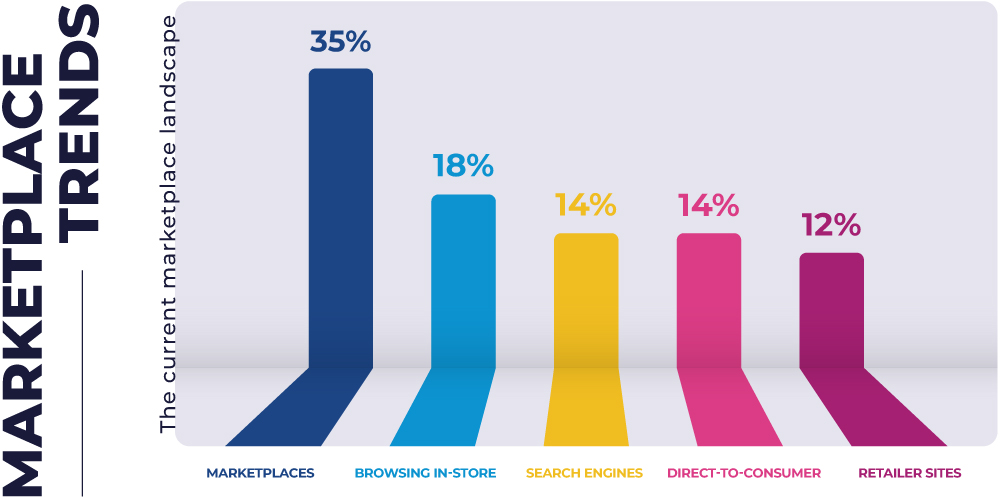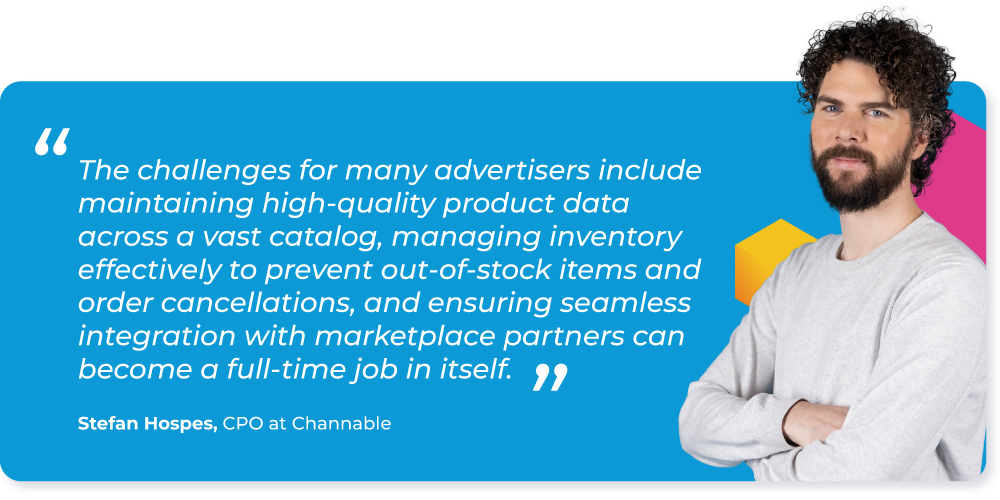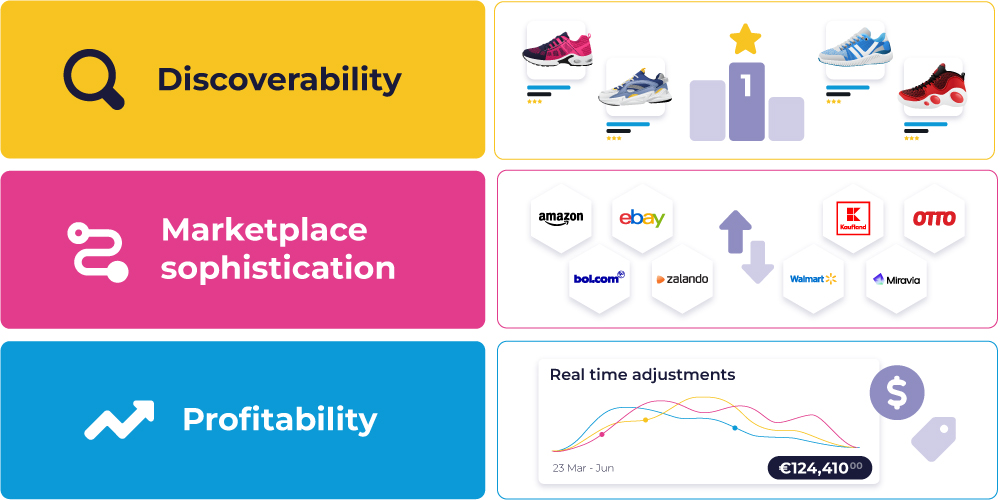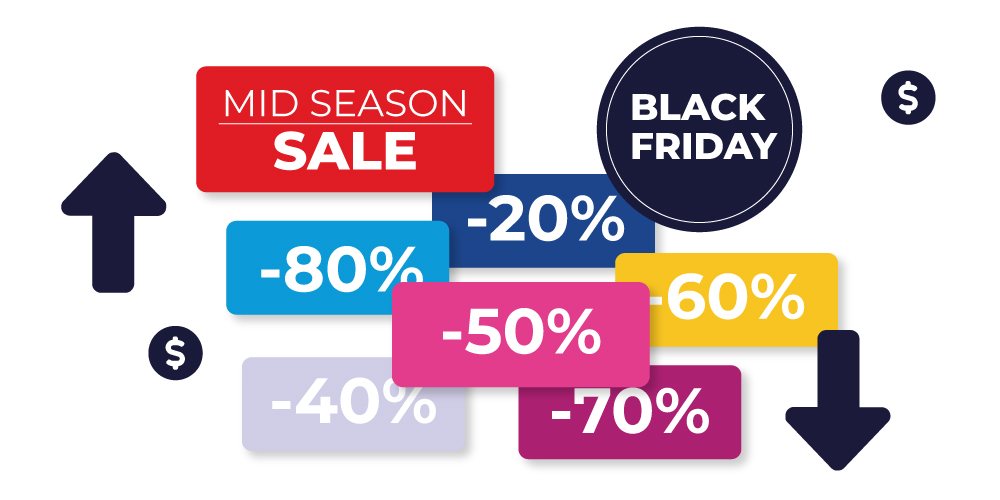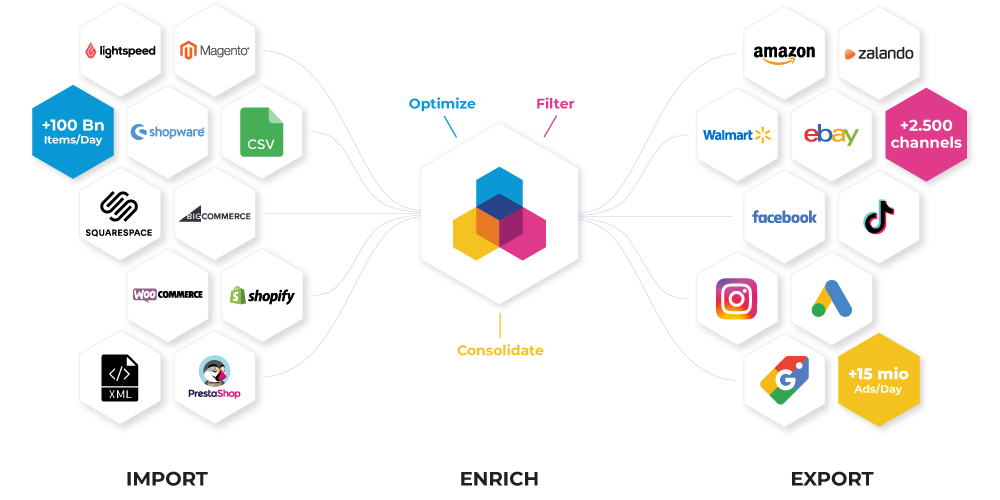Mastering Marketplace Dynamics: Navigating Trends, Challenges, and Strategies for Success


From navigating the complexities of eCommerce marketplaces to leveraging the rise of social commerce trends, businesses are urged to adapt and innovate in the ever-changing landscape of online advertising.
Topics Covered
- Marketplace trends
- Marketplace challenges
- The rise of social commerce
- How to start winning on marketplaces
- Key takeaways
- Automated multichannel eCommerce
1 ― Marketplace trends
The current marketplace landscape
eCommerce marketplaces have become indispensable for brands seeking to find, engage, and convert customers. Projections indicate that by 2027, a staggering 59% of all eCommerce sales will be facilitated through these platforms.
This growth in popularity is because marketplaces are not just a place to sell but have grown into search engines, ad platforms, and social media sites, making them increasingly complex for advertisers to navigate.
And it's not just Amazon and eBay we are talking about. Vertical, niche marketplaces are multiplying and have become too successful for brands to ignore. While Amazon is significant globally, there are many other marketplace opportunities for marketers to experiment and find success with.
Last year marketplaces were the most popular starting point for online shoppers with over 35% of consumers starting on marketplaces as a source of inspiration for their upcoming purchases according to Statista.
To capture customers' attention, the experience must be seamless, even as they hop across marketplaces and channels to connect and get the most out of your multichannel eCommerce strategy.
Even the most sophisticated marketers and agencies can have difficulty maintaining the consistency and accuracy of product data across channels and marketplaces.
We know it can be a struggle to get real-time insights and analytics on performance across channels and eCommerce marketplaces, often coming up against limitations in marketplace merchant centers and processes.
Plus, marketplaces – and their algorithms – are evolving daily, making it even trickier to grow, and reach targets, revenue, and profits.
So let’s dig a bit deeper into marketplace trends, and then see how savvy marketers can use the right frameworks, and the right technology solutions, to create a competitive advantage.
Shifting shopping trends
Remote work has intensified online shopping, with 65% of consumers buying more due to WFH and spending more time researching purchases. A desire for future WFH habits is expressed by 66% of consumers.
eCommerce has surged as a result, now representing 58% of consumer spending, and is projected to reach 64% within the decade.
*All figures in this section come from Hugh Fletcher and the VML Future Shopper Report
Shopper behavior
Consumers seek seamless multichannel experiences, emphasizing communication across channels. Mobile phones account for 32% of online spending, highlighting the importance of mobile optimization.
The digital customer journey predominates, with online advertisements inspiring 64% of purchases and 71% of searches occurring online.
Marketplaces dominate online shopping, driving inspiration and search for 35% of global shoppers. However, interest in physical retail and D2C brands is resurging, with physical stores ranking second for inspiration and search, and DTC brand sites experiencing a notable increase.
Social commerce is also on the rise, with 67% of shoppers making purchases through social media platforms, expected to increase in the future. Price also remains a key driver, with 56% of consumers prioritizing it, but they are willing to spend $378 on online purchases for quality products and experiences.
Service is also crucial, with hassle-free returns vital for customer retention. Sustainability, ethics, and purpose influence consumer behavior, with 52% altering their habits due to environmental concerns. As consumerism evolves in the digital age, nearly half of global shoppers prefer digital products, and transactions in virtual environments like the metaverse increase.
Simply put, the future of shopping is characterized by seamless integration across channels, a growing emphasis on social commerce, and an evolving consumer mindset shaped by hybrid work, sustainability concerns, and digital innovations.
Retailers and brands that adapt to these trends will thrive in this dynamic landscape.
*All figures in this section come from Hugh Fletcher and the VML Future Shopper Report
2 ― Marketplace challenges
Navigating the complexities of online marketplaces poses challenges for businesses of all sizes. From managing listings to optimizing products and ads, understanding and overcoming these hurdles is essential for success, especially when managing multiple accounts or marketplaces at the same time.
Challenges for SMBs
For most small and medium-sized businesses (SMBs) marketplaces are nothing new, they do face unique struggles however when venturing into the competitive first page of products.
With smaller SKU counts, uploading listings and managing campaigns may seem straightforward. However, as businesses grow, the process becomes increasingly complex.
Discoverability and marketplace sophistication quickly become complicated when you couple promoting brands effectively with constant marketplace updates and requirements.
Large SKU counts present challenges such as cumbersome Excel sheet uploads, time-intensive campaign management, and the risk of products becoming overlooked or unprofitable.
Sustainable growth becomes unattainable without the implementation of efficient strategies.
Valerie Dichtl from marketplace uni states:
Choosing the right solution involves assessing attributes and then selecting the marketplace or multichannel mix that best suits your business and strategy.
Solutions can even go a step further with some external partners providing support for various services, including product images, multiple marketplace API syncing, and customer support.
Challenges for enterprise-sized businesses
For enterprise-level businesses, scaling up marketplace operations brings its own set of challenges. While starting to sell on marketplaces may not be a primary concern, scaling efficiently is paramount.
Profitability, overhead costs, and complexities escalate with the expansion of SKU counts and marketplace presence.
Stefan Hospes, CPO at Channable, states:
Common efficiency gaps hinder large SKU businesses on marketplaces like Amazon, necessitating an assessment of scalability in current strategies.
Large SKU counts pose unique challenges, such as managing listings and advertising efficiently.
Winning strategies for these businesses include high-quality product data, relevant ads, performance-based segmentation, and expansion to other platforms.
A marketplace for everyone
While the challenges may differ for SMBs and enterprise-sized clients, the goal remains the same: to thrive in the competitive landscape of online marketplaces.
By understanding and addressing the 3 main challenges here head-on, businesses can position themselves for sustainable growth and success.
- Discoverability - With the proliferation of marketplaces, competition has become fiercer than ever. Agencies and brands must differentiate themselves quickly and constantly innovate to stand out in the crowded marketplace.
Discoverability involves more than just the product itself in the long term, product ranking will depend on the quality and consistency of your data.
- Marketplace sophistication - Algorithms and rules are constantly evolving, affecting the visibility and effectiveness of marketing campaigns. Consider how many times marketers have to adapt to other algorithms such as Google Shopping.
Staying updated with algorithm changes and adjusting strategies accordingly is crucial but can be challenging.
- Profitability - Rising dynamic pricing wars alongside attracting the right buyers can cause pricing headaches. Set goals and limits for yourself, to make sure you say within your margins.
3 ― The rise of social commerce
Product discovery has long been the weak link of eCommerce. But platforms like Instagram and TikTok are perfecting the art of showing customers something they didn’t know they needed, but suddenly crave.
The blurring boundaries of social commerce
Social commerce involves integrating shopping features directly into popular platforms like TikTok and Instagram.
These platforms have become more than just avenues for social interaction; they now serve as bustling marketplaces where users can seamlessly discover, explore, and purchase products without ever leaving their feeds.
Product discovery lies at the heart of social commerce. Platforms like Instagram and TikTok excel at presenting users with items they didn't know they needed but suddenly desire.
TikTok boasts impressive numbers, with users being 1.7 times more likely to purchase items discovered on the platform compared to other social media platforms. This trend underscores the significance of deeply understanding these platforms and presenting a unified brand presence across them.
For businesses, social commerce represents an opportunity to tap into the vast user bases of these platforms and engage customers in new and innovative ways.
Particularly popular with Gen Z, social commerce offers a fresh approach to shopping that aligns with their digital habits and preferences.
To navigate this evolving landscape effectively, businesses must leverage multichannel software solutions that can manage both traditional eCommerce and social commerce channels seamlessly.
Impact on marketplace dynamics
The rise of social commerce has had a profound impact on traditional marketplace dynamics, challenging established players and reshaping consumer behavior.
TikTok, in particular, has emerged as a key player in the social commerce arena, leveraging its vast user base to drive sales directly within the app.
Through features like its Shop functionality, TikTok enables users to complete purchases without leaving the platform, providing sellers unparalleled access to potential customers.
Meanwhile, Meta (formerly Facebook) has entered into partnerships with eCommerce giant Amazon to integrate shopping features seamlessly into its platforms.
The "Shop with Amazon" option on Instagram and Facebook allows users to browse and purchase products without disrupting their social media experience.
The battle for product search dominance is also heating up, with platforms like TikTok and YouTube gaining traction as preferred channels for product discovery among younger consumers.
This shift poses significant implications for advertisers, who must adapt their strategies to reach customers across diverse platforms while maintaining their overview and direction.
Getting with the times
The rise of social commerce represents a seismic shift in the digital marketplace landscape. By integrating shopping features directly into social media platforms, businesses can capitalize on user engagement and drive sales in ways previously unimaginable.
However, success in social commerce requires a deep understanding of platform dynamics, a unified brand presence across channels, and the adoption of multichannel software solutions to navigate the complexities of this emerging landscape.
As platforms like TikTok and Instagram continue to innovate and evolve, businesses must stay agile and proactive in their approach to social commerce.
By embracing this new paradigm and leveraging the power of social media for product discovery and purchasing, brands can unlock new opportunities for growth and differentiation in an increasingly competitive marketplace.
4 ― How to start winning on marketplaces
In the competitive landscape of online marketplaces, standing out and achieving success requires a strategic approach. In this section, we delve into Channable's success formula, encompassing vital tactics to thrive in the dynamic world of eCommerce marketplaces.
Channable's success formula
Establishing a robust framework for success on marketplaces is essential for brands and retailers. Channable's success formula offers a strategic roadmap to optimize marketplace presence effectively. Let's explore each step to harness its full potential.
Marketplace identification
Identifying the marketplaces where your Ideal Customer Profile (ICP) is active is crucial for tailoring marketing and sales strategies effectively, involving steps such as conducting customer interviews, monitoring marketplace expansion and growth, and thoroughly analyzing marketplace needs and demands in relation to your products and services:
- Deepen understanding of ideal customer profile (ICP) shopping behavior
Conduct customer interviews and market research to understand the shopping behaviors of ICP's.
- Monitor marketplace expansion and growth
Utilize strategic frameworks like quadrants to assess the competitive landscape, identifying emerging players and potential disruptors while gauging market dynamics and trends.
This means building a multichannel mix of larger marketplaces like Amazon and niche marketplaces that fit a business's products and offerings.
- Thoroughly analyze marketplace needs and demands to optimize your strategies
Every marketplace has its own requirements such as image requirements - Before you get going, companies must understand the evolving requirements and expectations within their marketplace ecosystem.
Product data optimization is key
Optimizing product data is the cornerstone of marketplace success, enhancing visibility and driving conversions. High-quality product data sets the stage for differentiation and competitiveness. Here's how to maximize impact:
-
High-quality product data
Ensuring all product data fields are meticulously filled and updated, accompanied by captivating images and keyword-rich titles and descriptions, is imperative. -
Differentiation from competition
Stand out by offering competitive prices, leveraging promotional highlights, and showcasing enticing delivery options like free shipping.
This strategy can be coupled with automation to enable dynamic fields for flash sales to drive interest.
- Title optimizations
Crafting optimized titles tailored to specific product categories enhances discoverability and relevance, vital for attracting the right audience with the intent to buy.
Place important product features directly between the name of your product and the title keywords.
Crafting relevant ads
Creating targeted and compelling advertisements is pivotal in capturing the attention of potential customers on marketplaces. Here's how to craft ads that resonate:
- Understand your audience
Using Amazon Ads as an example, they are tailored specifically for the Amazon marketplace, targeting users who are already in a purchasing mindset. Prioritize keyword research to ensure ads appear for relevant search queries.
Utilize tools like Amazon's own "Amazon Keyword Tool" to identify high-converting keywords. Additionally, analyze past customer data and utilize Amazon's targeting options for more effective audience segmentation.
- Optimize campaign structure and content
Organize Amazon Ads campaigns effectively by structuring them hierarchically, from campaign to ad group to keywords/targets.
A best practice for a product launch is to create multiple campaigns for the product. Starting with an automatic campaign. After about two weeks one or more campaigns with manual targeting can be created from the learnings.
Then move the best-performing keywords and product targets to these manual campaigns and exclude them from the automatic campaigns using negative keywords.
- Make use of visual appeal
Every optimized listing needs the right image material. Images are the first thing looked at when shopping. The diverse expansion of marketplaces and verticals introduces varying specifications and ratios. Inevitably, many leading marketplaces impose restrictions on accepted image types, which are crucial to get right from the start for optimal performance.
Ensure that the final creatives align with your brand's image, messaging, and identity across all channels by creating branded templates for product images and descriptions to maintain visual consistency.
Effective pricing and repricing
Protect your brand and capture that sale by implementing automatic price adjustments. This technique enables precise targeting of specific campaign goals and amplifies the impact of marketing efforts. Here's how to leverage automated pricing effectively:
- Automatic Price adjustments
With this strategy, prices are dynamically adapted to the current competitive landscape, maximizing revenue and ensuring competitiveness. This is possible with a repricer like Channable.
This trend is particularly prominent on Amazon, where approximately 63% of shoppers say they always compare prices before purchasing from other platforms. For example, during events like Black Friday, SaaS deals or Amazon prices change every 15 minutes. The ability to swiftly modify prices based on competitors' pricing is crucial.
-
Price and repricing
Stay ahead of the competition by repricing just below the cheapest price of competitors. Set a minimum for this, to never suffer losses! If there is no competition, then arrange to show the maximum price! -
Customer score
If a competitor has a lower score on this field, a rule can be set to determine whether to compete on price. Because if your business has a higher customer score, the chance of a buy-box win is higher and there is less need to cut margins. -
Delivery time
Again, if a competitor offers longer delivery times compared to your shop, there is less need to compete on price. The rules that are set here ensure price reductions are not applied unless necessary to compete.
Always up to date inventory
Sync and update inventory in the real with marketplace API connections to boost margins quickly. The more streamlined the process is, the more to win and grow.
- Inventory moves 24/7 in eCommerce
It's super important that the products offered are actually in stock. Not only for the customer experience but also for profits, short selling is unnecessary.
Customers often come to us and say that they constantly have short sales, something was sold on eBay but their store only adjusts after 40 minutes. That is of course unfavorable. Retailers are often surprised by the power of marketplaces and are surprised at how quickly their products sell.
- Utilize solutions that update and synchronize your stock
With the power of real-time API connections, stocks can be adjusted across a wide range of channels and products that are out of stock will no longer be advertised.
Tracking stock can not only help with item management but based on this, you can better plan discounts or product bundles.
Integrate with socials
Social channels can boost a company's brand awareness, improve customer loyalty, and increase reach and conversions. If social selling is something new here are some tips to get started:
-
Use shoppable posts and product tags
These make shopping on social media easier by integrating purchase options directly into the posts, which simplifies the purchasing process and increases the conversion rate. -
Promote customer-generated content
Real reviews and experiences from customers offer authentic insights. Combine this with interactive product presentations, such as 360-degree views or augmented reality features. -
Developing a cohesive content strategy
A strong content strategy is critical to success. Channable helps businesses maintain a consistent brand presence across platforms and tailor their content specifically for each audience while helping with data and channel management.
Further expansion strategies
Expanding to additional platforms unlocks new opportunities for increased reach and revenue. Here are a few more strategic approaches to expansion:
- Search & Performance Max integration
Combine Search and Performance Max ads for a powerful advertising synergy, leveraging advanced options like ad customizers to enhance specificity and effectiveness.
If strategies are streamlined across channels reach can be extended beyond just marketplaces creating a true multichannel strategy.
- Performance based campaigns
Implementing performance based segmentation optimizes budget allocation, ensuring resources are directed towards high-performing products, thus enhancing overall account performance and return on ad spend.
For example, ads can be organized into asset groups based on themes such as categories or brands, and tailor assets accordingly to ensure relevance and resonance with the target audience.
- Advanced product bucketing
Utilize advanced segmentation techniques, incorporating data sources beyond Google's performance metrics, to fine-tune targeting and maximize ROAS.
Asset creation can be streamlined even further using dynamic fields within solutions like Channable, minimizing manual efforts while maximizing relevance across asset groups.
All things said, implementing something like Channable's success formula empowers your business to optimize product data, create relevant ads, implement effective pricing, and test expansion strategies, to position yourself for sustained growth and dominance in the ever-evolving eCommerce landscape.
5 ― Key takeaways:
Mastering marketplace dynamics requires a keen understanding of emerging trends, adept navigation of challenges, and the implementation of effective strategies.
Key takeaways from this exploration include:
-
Adaptation is key: Businesses must stay open-minded in responding to marketplace trends and consumer preferences, leveraging tools and frameworks like Channable's success formula to optimize their presence and maximize growth opportunities.
-
Understanding marketplace challenges: Whether facing challenges as a small or medium-sized business with limited SKUs or as an enterprise-level seller managing large inventories, businesses must address hurdles such as product data optimization, effective advertising, and scalability for a successful multichannel strategy.
-
Embracing social commerce: The rise of social commerce presents new avenues for engagement and sales, requiring advertisers to integrate platforms like TikTok and Instagram into their strategy while maintaining a unified brand presence across channels.
-
Strategic expansion: Expanding to additional platforms and exploring dynamic campaign strategies can unlock new opportunities for increased reach and revenue, enabling companies to scale even further.
-
Agility and Innovation: Success in the eCommerce marketplace landscape hinges on agility and innovation, with automation and insights serving as key drivers for growth and resilience in the face of evolving challenges and opportunities.
6 ― Automated multichannel eCommerce
By embracing automation and strategies like our success formula and staying proactive in addressing marketplace challenges, companies can position themselves for growth and resilience, with Channable here to help support goals.
We know navigating a marketplace strategy can seem like scaling a mountain, but Channable's automation offers a practical solution for achieving success in marketplace campaigns and connections.
Our automation platform helps brands, retailers, and agencies manage and optimize product data centrally in one interface. We are serving as middleware between your shop and all relevant marketing platforms.
Allowing businesses to import product data, make changes and optimizations, and export data to various channels.
Our platform also includes multiple features such as rules and channel mapping that help optimize feeds across multiple channels (marketplaces, comparison and affiliate sites, social media advertising platforms…More than 2,500 sales channels!)
With this powerful all-in-one platform, automate the entire marketing process, significantly increase data quality, and create better visibility and performance, helping work more efficiently, reduce manual tasks, and save valuable time that could be spent instead on strategic tasks.
Check out Channable marketplace video series to learn more and determine if automation is the right solution to take your ads to the next level.
Want more like this?
Want more like this?
Insight delivered to your inbox
Keep up to date with our free email. Hand picked whitepapers and posts from our blog, as well as exclusive videos and webinar invitations keep our Users one step ahead.
By clicking 'SIGN UP', you agree to our Terms of Use and Privacy Policy


By clicking 'SIGN UP', you agree to our Terms of Use and Privacy Policy
Other content you may be interested in
Categories
Categories
Categories

Want more like this?


Want more like this?
Insight delivered to your inbox
Keep up to date with our free email. Hand picked whitepapers and posts from our blog, as well as exclusive videos and webinar invitations keep our Users one step ahead.
By clicking 'SIGN UP', you agree to our Terms of Use and Privacy Policy



